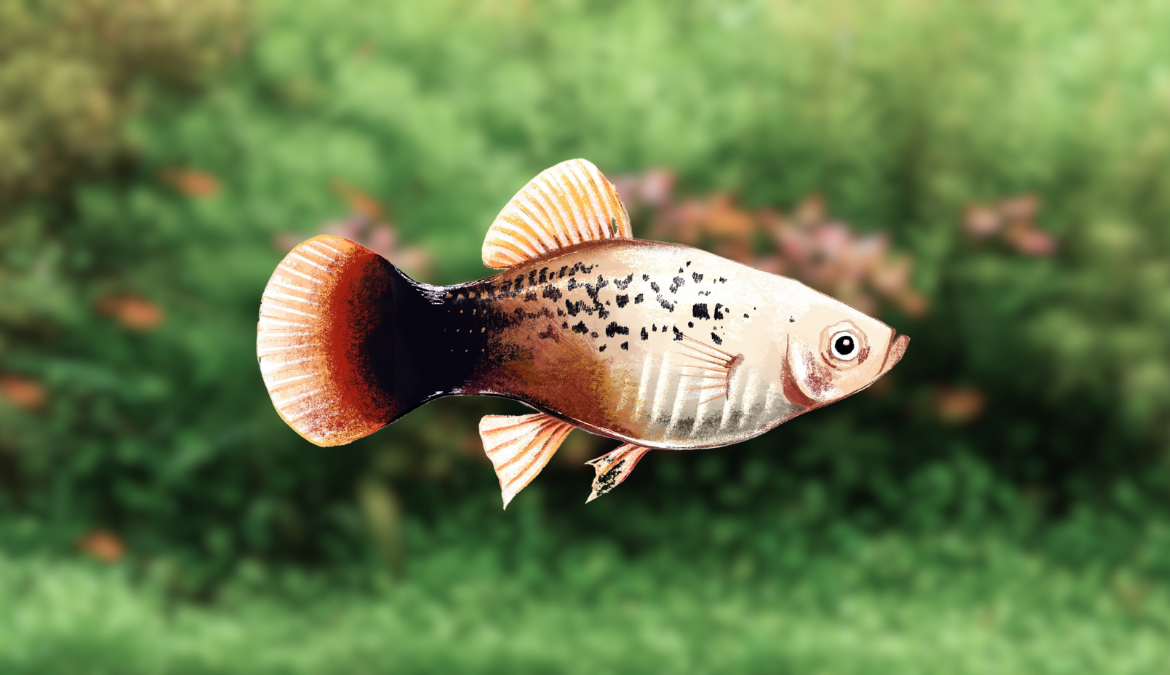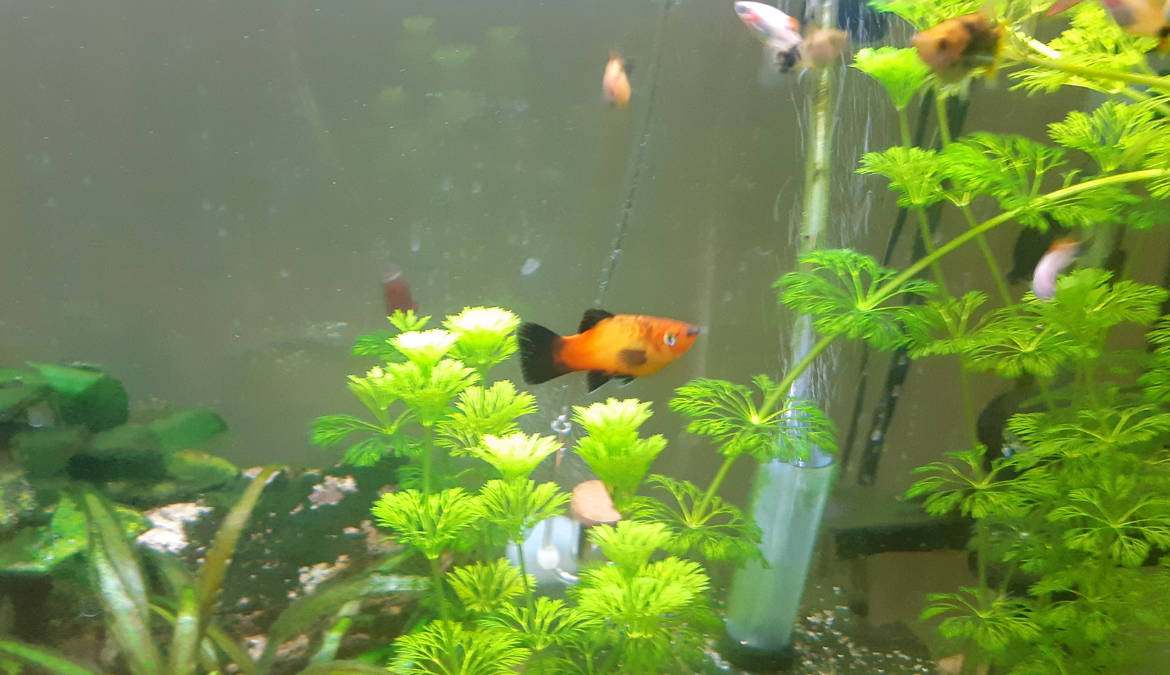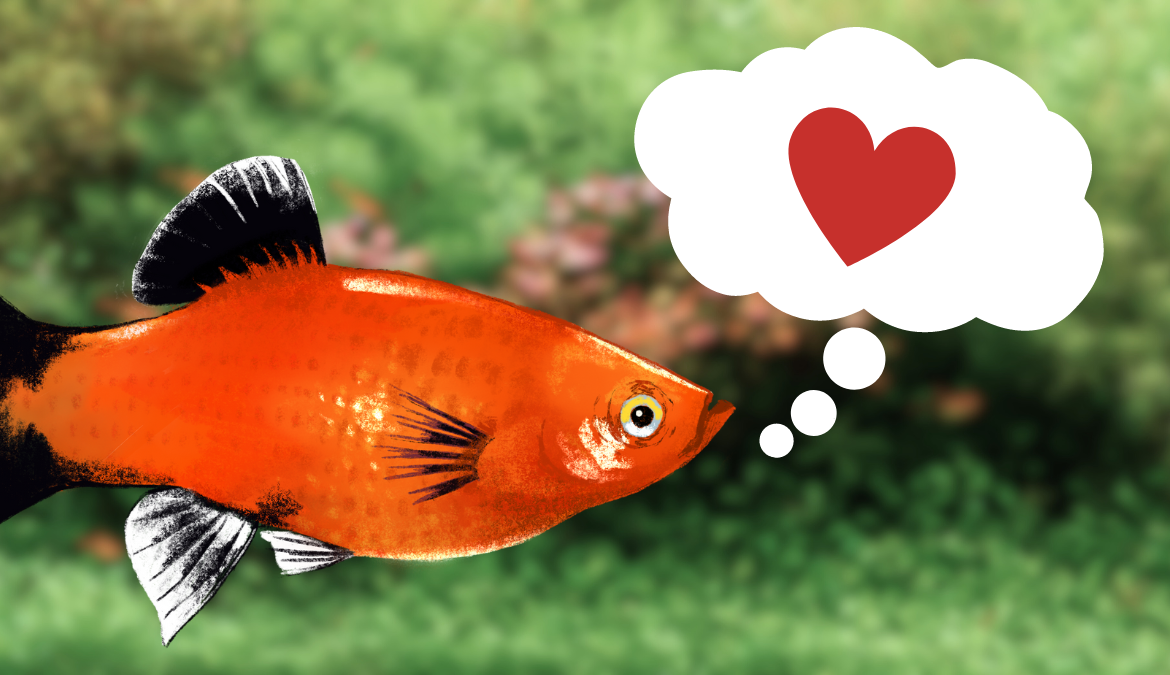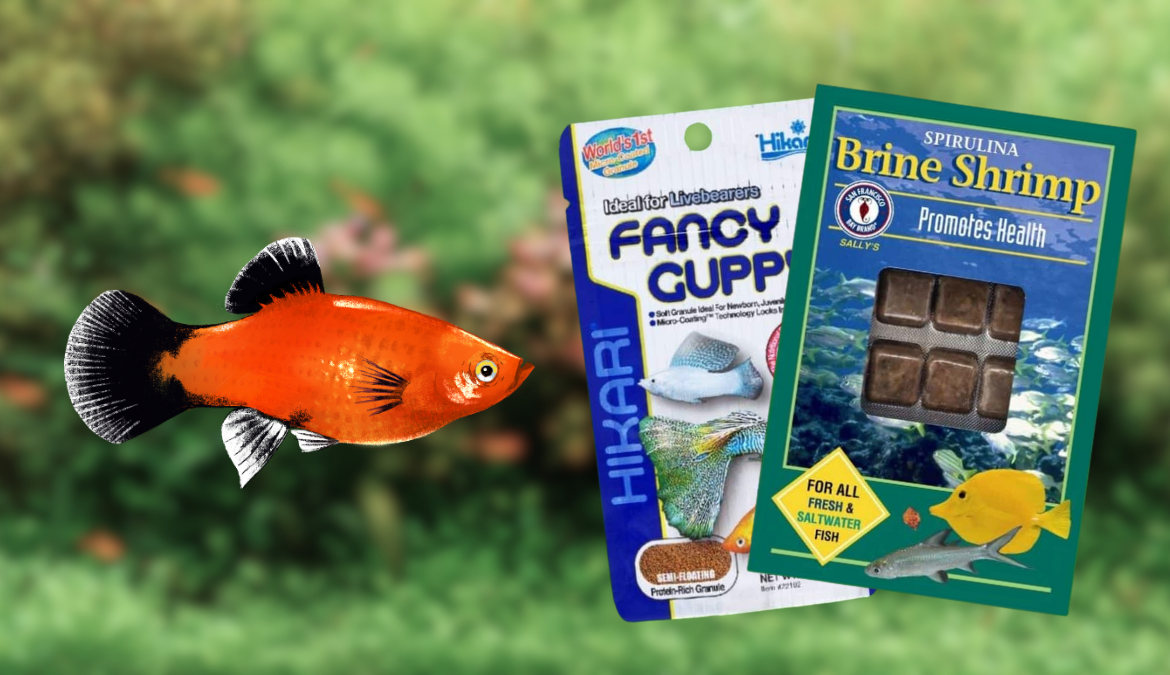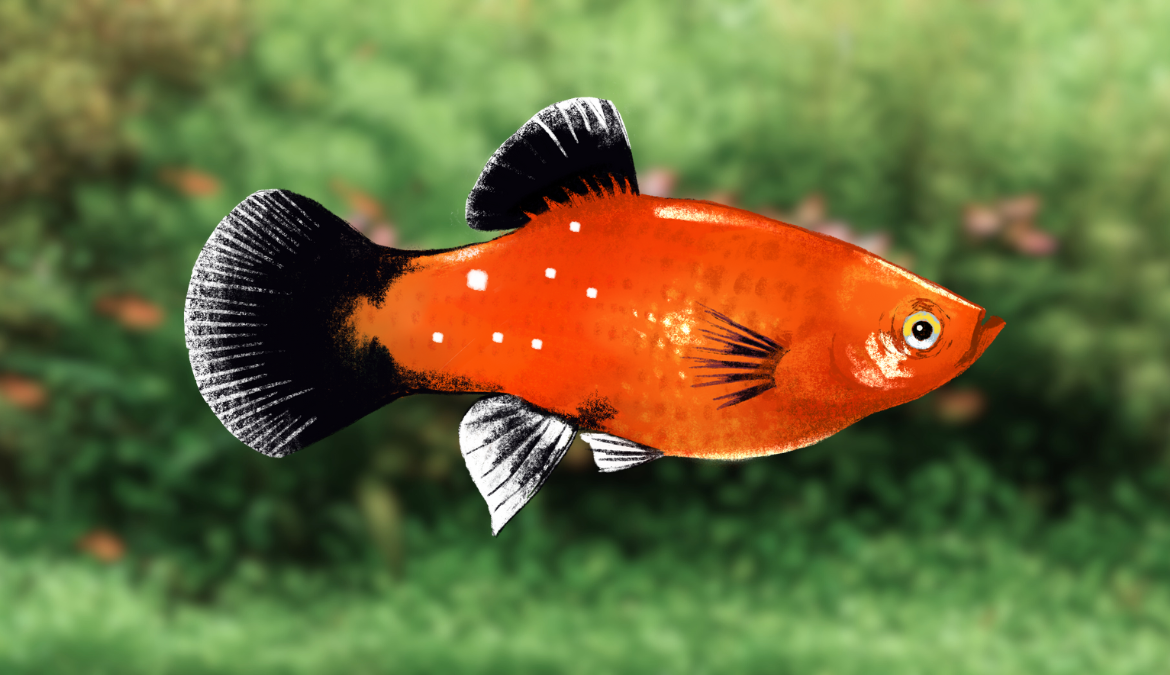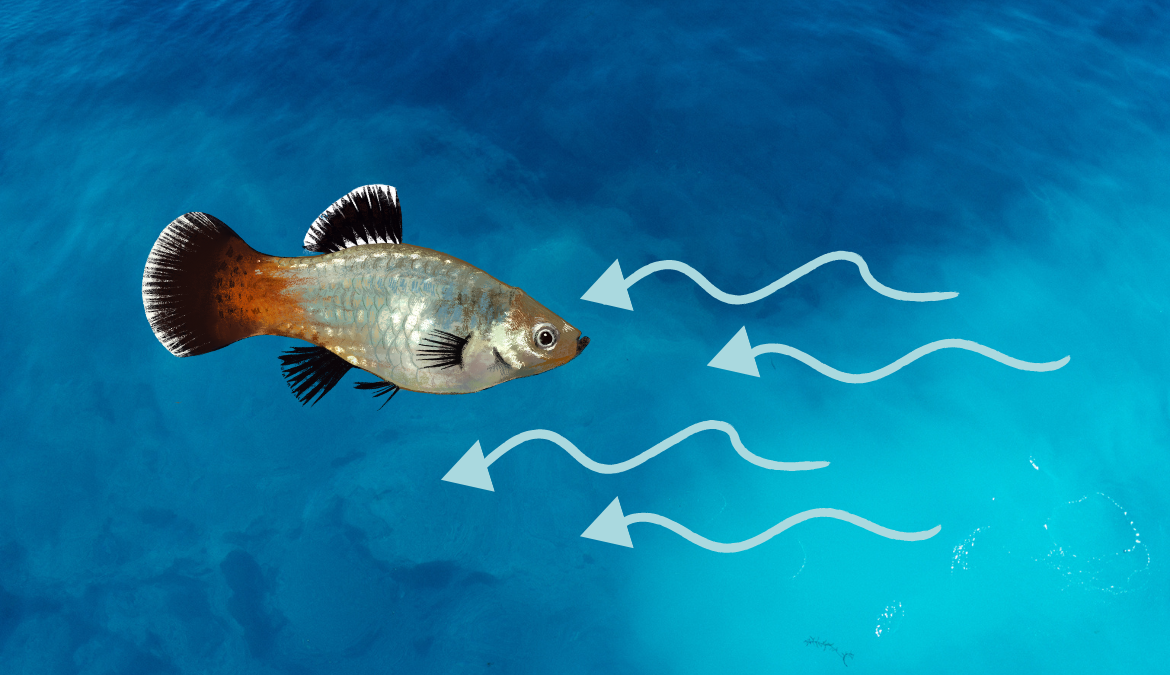Foraging, exploring, hiding ad socializing are the four pillars of platy fish happiness and enrichment. This involves recreating their natural habitat, providing a balanced diet, fostering social interaction, and periodically changing the tank layout.
Each step contributes to better health, growth, and a more vibrant life for your platy fish. Providing an enriched environment that encourages your platy fish’s natural behaviors is essential for their well-being.
Here are my best tips for maximizing your platies’ enrichment:
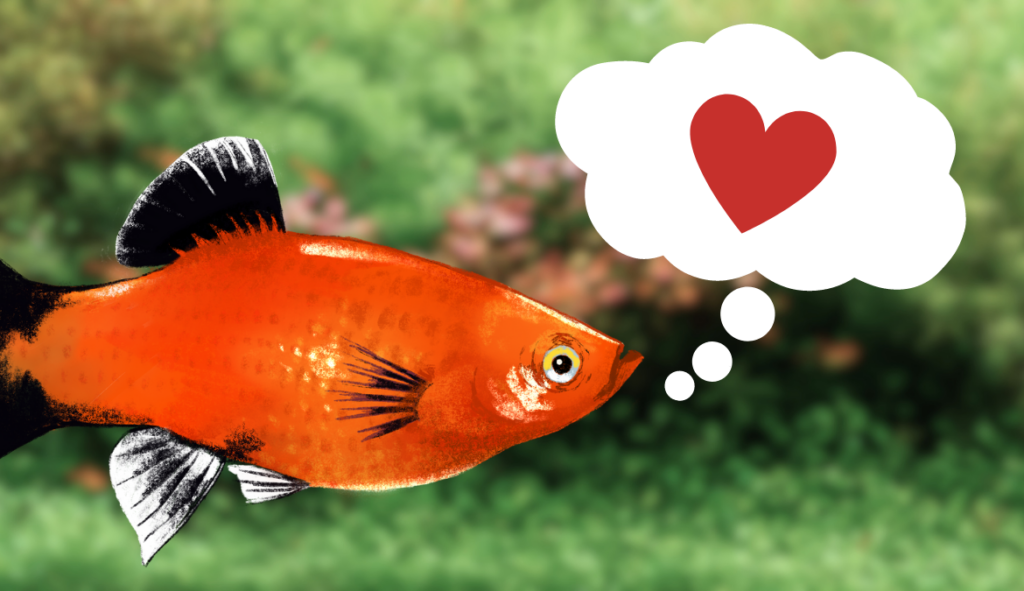
Contents
- 1 Understanding Platy Fish Natural Behaviors
- 2 Types of Natural Platy Fish Behaviors That Can Be Enriched
- 3 The Importance of Enriching the Aquarium Environment
- 4 Creating an Ideal Aquarium Setup for Platy Fish
- 5 Providing a Balanced Diet for Natural Foraging Behavior
- 6 Encouraging Social Interaction
- 7 Ensuring Enough Space and Hiding Spots
- 8 Mimicking Natural Light and Water Current Conditions
- 9 Temperature and Water Quality
- 10 Preventing Stress and Disease
Understanding Platy Fish Natural Behaviors
Overview of Platy Fish Behavior in the Wild
Platies are active and social creatures that thrive in diverse and dynamic environments. In their natural habitat, platy fish spend their day foraging for food, exploring, and interacting with other fish.
They are typically found in warm, slow-moving waters with abundant vegetation, and their behavior is largely dictated by the:
- Availability of food;
- Complexity of their habitat;
- Presence of predators; and
- Compatibility of companions.
Understanding their behavior in the wild can help create an ideal aquarium environment that will stimulate these natural behaviors.
Types of Natural Platy Fish Behaviors That Can Be Enriched
Platy fish exhibit a variety of natural behaviors that can be categorized into foraging, exploring, hiding, and socializing.
Foraging: Platies are omnivorous and spend a significant part of their day searching for food.
Exploring: They are curious fish that enjoy investigating their surroundings, especially when new objects or layouts are introduced.
Hiding: When threatened or stressed, platies will seek out hiding places to escape perceived dangers.
Socializing: Platies are social creatures and thrive on interaction with other fish.
Creating an environment that supports these behaviors is crucial to their well-being and can make your platies more active and engaging to observe.
How to Enhance Platy Foraging Enrichment
Enriching the environment of your platy fish with foraging opportunities is an excellent way to stimulate their natural behaviors and improve their overall health and well-being. Here are some strategies to improve foraging enrichment for platy fish:
- Variety of Foods: Providing a variety of different foods can encourage your fish to forage. This could include a mix of pellets, flakes, live foods, and freeze-dried foods.
- Live Foods: Live foods are excellent for promoting natural foraging behavior. Options for platies include brine shrimp, daphnia, and bloodworms. Be careful not to overfeed and make sure to source these foods from reliable suppliers to avoid disease.
- Vegetation: Platy fish are omnivorous, and in the wild, their diet includes aquatic plants. Adding live plants to the aquarium gives them the opportunity to graze. They typically don’t eat a lot of plant matter but it can contribute to their overall diet.
- Feeding Methods: Change up the way you deliver food. Sometimes drop the food directly into the tank, sometimes let it float on the surface for a while, other times use a feeding ring to contain the food in one area. This variability encourages exploration and foraging.
Remember, enrichment should be monitored to ensure it is safe and beneficial for the fish. Keep an eye on water quality as increased food and live plants can alter it.
Monitor the fish’s behavior to make sure they are not stressed or displaying aggressive behavior. If you notice anything off, make adjustments as necessary.
How to Enhance Platy Exploring and Hiding Enrichment
Creating an environment that promotes exploration for your platy fish can be a great way to increase their enrichment and overall well-being. Here are some ideas on how you might do this:
- Variety of Hiding Spots: Providing a variety of hiding spots is crucial for creating an exploratory environment. This can be accomplished with live plants, rocks, caves, driftwood, or special aquarium decorations. Fish often enjoy exploring new areas, finding new hiding spots, and establishing territories.
- Change the Environment: Occasionally rearrange the decorations and plants in the tank. This can encourage the fish to explore and adapt to a new layout, stimulating their cognitive function. However, avoid frequent changes as it might stress them.
- Layering: Try to create a multi-layered environment. Platy fish inhabit all levels of the water column, so providing interest at the bottom, middle, and top of the tank can encourage exploration.
- Live Plants: Live plants are better than artificial ones for enrichment because they grow and change, providing a dynamic environment for your fish. They also help to oxygenate the water and provide additional hiding spots. Some good options for platy fish include java moss, java fern, and anubias.
- Lighting: Lighting changes can stimulate exploration. Using an aquarium light that can mimic sunrise and sunset can promote natural behavior in your fish. Avoid abrupt changes in lighting as it can stress your fish.
- Large Tanks: Larger tanks provide more space for exploration. Platy fish do well in tanks of 20 gallons or more, but larger is always better when it comes to fish tanks.
Remember to closely monitor your fish and their environment for any signs of stress or illness.
All changes should be made gradually to avoid causing undue stress to your fish. Always consider the welfare of your fish when making any changes to their environment.
How to Enhance Platy Social Enrichment
Platy fish are social creatures that often thrive in community tanks, and a good social environment can greatly improve their well-being. Here’s how you can encourage social interaction among your platy fish:
- Group Size: Keeping platy fish in a small group can encourage social interaction. They do well in groups of 5 or more, although the exact number will depend on the size of your tank.
- Mixed Sex Groups: Having both male and female platy fish can encourage social behavior. Usually a 1:3 male:female ratio is best to minimize stress.
- Tank Mates: Choose compatible tank mates to encourage peaceful interaction. Platy fish do well with other peaceful community fish. Good tank mates can include other livebearers such as guppies and mollies, as well as tetras, danios, and certain types of gourami.
- Feeding Time: Feeding time is a great opportunity to encourage social behavior. Feed your platies small amounts of food once per day, and watch them interact with each other as they eat.
- Tank Environment: A well-arranged tank can encourage social interaction. Make sure to provide enough open swimming space, as well as areas with cover for the fish to hide if they feel the need. This can make your fish feel safe and comfortable, encouraging more social interaction.
Remember to always monitor your tank closely for signs of aggression or stress, and to adjust as necessary. Changes in behavior, color, or eating habits can be a sign of stress or illness.
A healthy, happy community tank requires regular maintenance, including regular water changes, monitoring water parameters, and providing a varied diet.
The Importance of Enriching the Aquarium Environment
Impact of the Environment on Platy Fish Behavior
Platies are highly influenced by their surroundings. A poorly set up tank can lead to stressed, lethargic fish, while an enriched environment can promote healthy, natural behaviors.
An enriched environment also provides mental stimulation, reduces stress, and can lead to improved health and longevity. Read more about platy behavior and how it’s influenced by their environment.
Benefits of Encouraging Natural Behaviors in Platy Fish
Encouraging natural behaviors in your platies is beneficial for both the fish and the fish keeper.
For the fish, engaging in natural behaviors contributes to physical health, reduces stress, and can improve their overall quality of life.
For the fish keeper, watching your platies behave as they would in the wild can be an incredibly rewarding aspect of the hobby, as it provides insight into their fascinating lives.
It’s also a sign that you’re providing a suitable environment for your fish, which is ultimately the goal of every responsible fish keeper.
Creating an Ideal Aquarium Setup for Platy Fish
Tank Size and Design: Recreating Natural Habitat
Creating an environment that closely mimics a platy’s natural habitat is the first step in encouraging natural behaviors. Platies come from warm, slow-moving waters in Central America, which are typically rich in vegetation and provide plenty of hiding spots.
While it’s impossible to recreate this environment perfectly, there are a few key factors to consider when setting up your tank.
Choosing the Right Plants and Decorations
The addition of live plants and decorations like rocks, caves, and driftwood to your platy aquarium can significantly enhance their living environment. Plants not only provide hiding spots but also enrich the water quality and serve as a natural food source.
Some platies may also enjoy nibbling on soft-leaved plants. Aquatic ferns, Anubias, and Amazon swords are all excellent choices for a platy tank. But really any live plant species will do.
For more about live plants suitable for platy aquariums, take a look at our detailed guide.
Decorations such as caves, rocks, and driftwood not only add visual interest to your tank but also provide essential hiding spots.
Placing these items thoughtfully can help create a stimulating environment that encourages exploration. Take note that all decorations should be free of sharp edges to prevent injury.
Creating Ideal Water Conditions
Like all fish, platies have specific water conditions they prefer. Providing these conditions is crucial to their health and well-being and can greatly influence their behavior.
Platies prefer warm water (around 75-80 degrees Fahrenheit) with a pH between 7.5 and 8.5. It’s also important to regularly check the water for ammonia, nitrites, and nitrates, as these can all be harmful to fish in high concentrations.
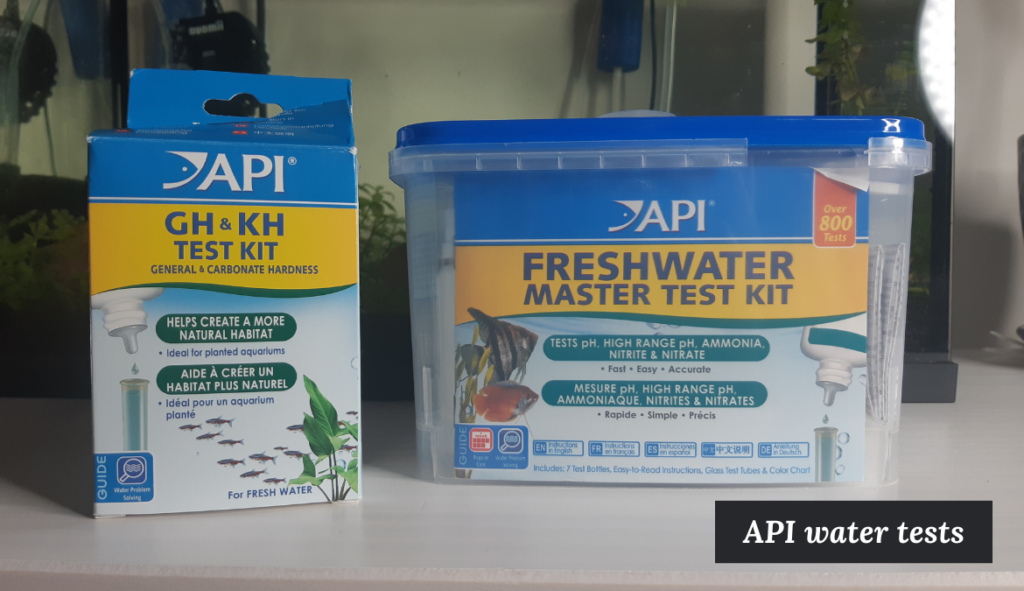
Water changes should be carried out regularly to maintain optimal conditions. For more information on ideal platy water parameters, check out our comprehensive guide.
Providing a Balanced Diet for Natural Foraging Behavior
The Importance of a Varied Diet
One of the most essential ways to encourage natural behaviors in platies is by providing a balanced and varied diet.
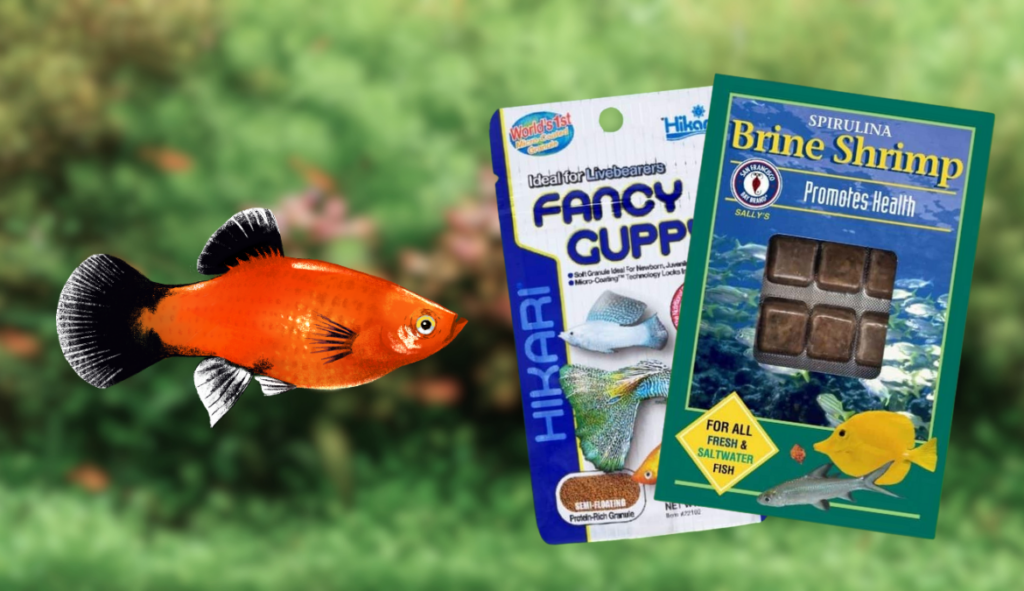
Platies are omnivorous and will eat a wide range of foods in the wild. By offering a mix of commercial fish flakes, live foods, and vegetables, you can mimic this variety and stimulate natural foraging behavior.
Live Foods and Vegetable Supplements
Live foods like brine shrimp, daphnia, and bloodworms can be an excellent supplement to your platy’s diet. They not only provide essential nutrients but also trigger natural hunting and foraging behaviors.

Vegetables like boiled zucchini, peas, and cucumber slices can also be offered occasionally. For more detailed information on feeding your platy fish, please check out our comprehensive guide.
Encouraging Social Interaction
Platy Fish Social Structure
Platies are social creatures and thrive in groups. In their natural habitat, platies live in loose social groups where interaction with other fish plays a significant role in their day-to-day behavior.
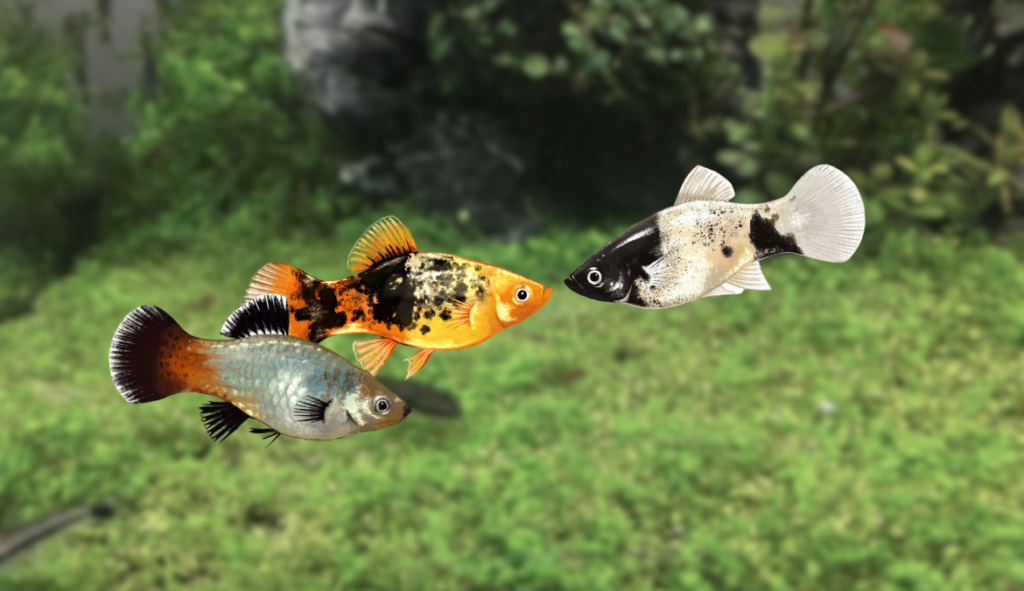
In the aquarium, platies should ideally be kept in groups of five or more. This promotes natural social interaction, reduces stress, and makes for a more lively tank.
Keep in mind, however, that platies breed readily, and overpopulation can be an issue if not managed properly. For more information, read our article on how many platies should be kept together.
Gender Ratio in Platy Fish
Managing the gender ratio in your platy aquarium can significantly affect their social behavior. It’s typically recommended to keep a higher ratio of females to males, ideally three females for every male.
This prevents the females from being harassed excessively by the males, which can lead to stress and health problems. Also, when the male platies are outnumbered, they are less likely to behave aggressively and more likely to show courtship behavior, which can be quite engaging to observe.
Platy Tank Mates
Choosing suitable tank mates for your platies can also influence their behavior. Ideally, platies should be housed with other peaceful species of a similar size. Aggressive or overly active tank mates can stress platies and may prevent them from exhibiting their natural behaviors.
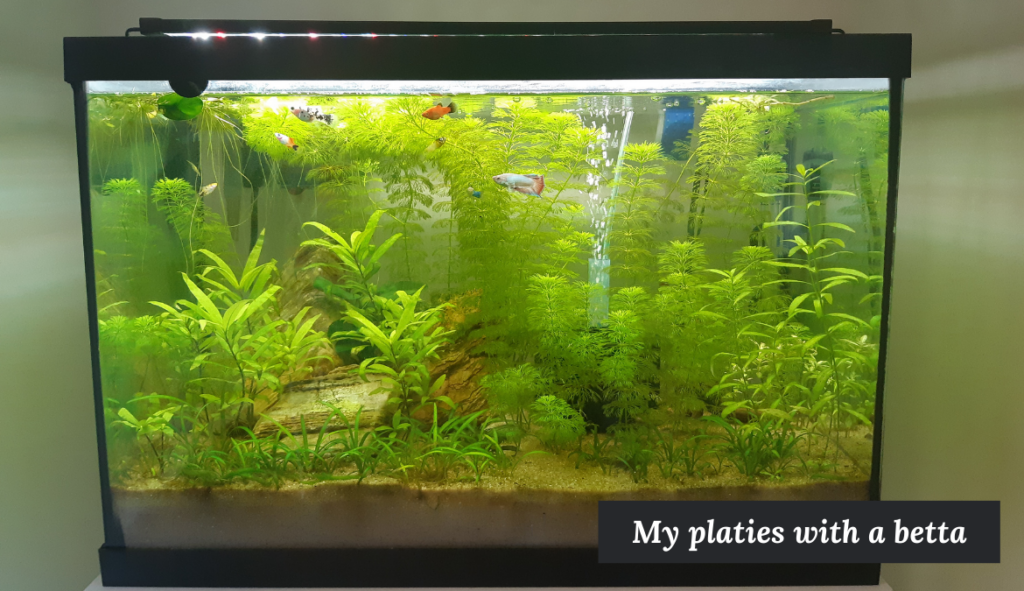
Good tank mates for platies include guppies, mollies, tetras, and peaceful species of dwarf cichlids. Make sure to check out our comprehensive guide on platy tank mates for more information.
Ensuring Enough Space and Hiding Spots
Space for Free Movement
Platies are active swimmers and need ample space to roam freely. The more space they have, the more likely they are to display natural behaviors such as exploring, foraging, and social interactions.
As a general rule, a tank of 10-20 gallons should provide enough space for a small group of platies. However, if you plan to keep a larger group or add other species, you’ll need a bigger tank. For more detailed information, read our guide on ideal platy fish tanks.
Hiding Spots and Security
Providing plenty of hiding spots is vital in replicating a natural environment and encouraging natural behaviors. Hideaways offer a sense of security, reduce stress, and can also act as territories for platies.
These can be created using live plants, rocks, and caves, as discussed earlier. For a better understanding of how to provide suitable hiding spots for your platies, read our detailed article.
Mimicking Natural Light and Water Current Conditions
Lighting Conditions for Platies
Platies, like most fish, are sensitive to light and darkness, and their behavior can be greatly influenced by the lighting conditions in the tank. Natural light cycle mimicking dawn, day, dusk, and night can promote their well-being and natural behaviors.
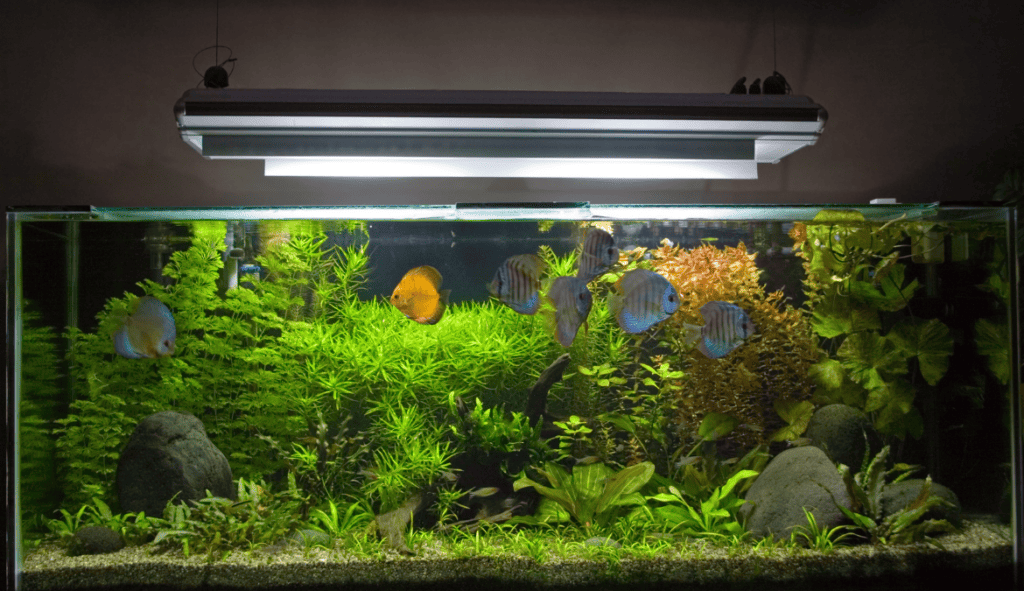
This cycle can be easily automated with a timer on your tank lights. Too much light or irregular light cycles can cause stress and lead to unusual behavior.
Water Current
Water current can also significantly affect platy behavior. In their natural habitat, platies live in slow-moving waters. Thus, a gentle current in the tank can make the environment feel more natural to them and encourage normal behavior.
Too strong a current, however, can cause stress and even physical harm. For more information on creating ideal water movement for platies, check out our guide on water movement for platies.
Temperature and Water Quality
Keeping the Ideal Temperature
Temperature plays a significant role in the lives of platy fish. A steady temperature within their preferred range 75-80°F (24-27°C) is crucial for their health and promoting natural behaviors.
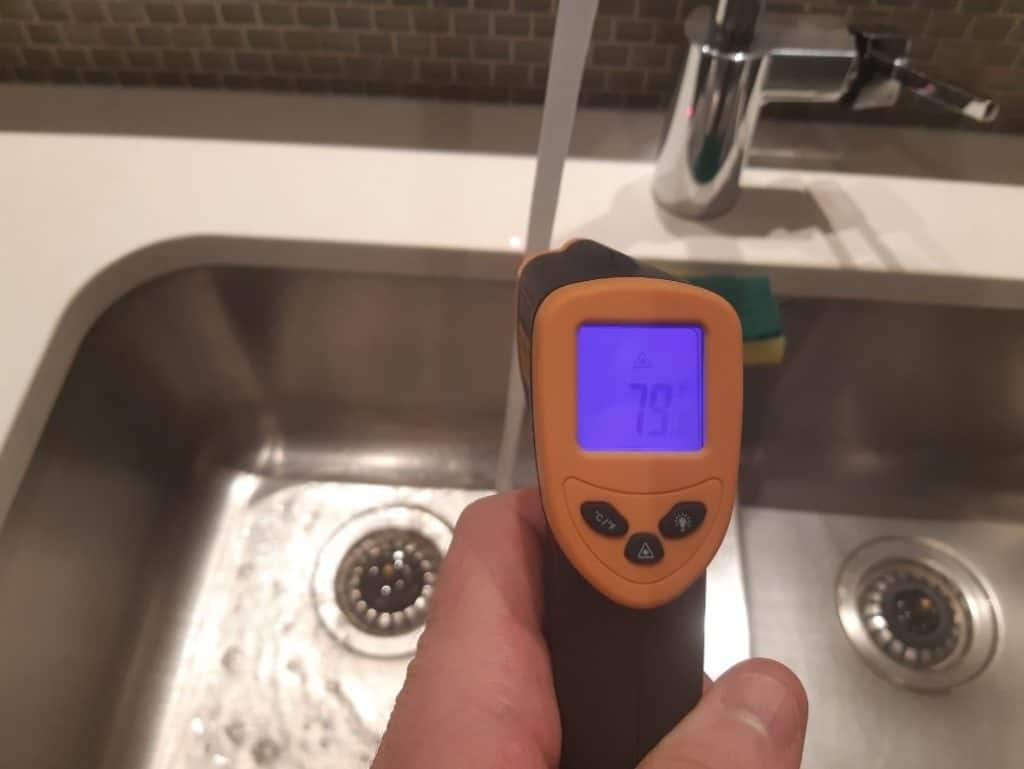
Changes in temperature can cause stress in fish and even lead to disease. It’s recommended to use an aquarium heater and a reliable thermometer to maintain consistent water temperature in your platy tank.
Maintaining Optimal Water Parameters
Platies are hardy fish, but they still need good water quality to thrive and exhibit natural behavior. Essential water parameters to monitor include pH, hardness, and ammonia, nitrite, and nitrate levels.
Platies prefer slightly alkaline water with a pH of 7.5-8.5 and moderate hardness. Regular water changes and using a good quality filter can help maintain optimal water quality.
Preventing Stress and Disease
Monitoring Platy Behavior and Health
Regular observation of your platies’ behavior can help identify signs of stress or disease early on. Unusual behaviors like hiding, lethargy, or aggression can indicate stress or underlying health issues.
It’s also essential to check for visible signs of disease, like spots, fin damage, or changes in color. If you notice any signs of illness, it’s crucial to take action quickly to prevent further spread. Read our article on platy disease prevention for more information.
Managing Tank Population
Finally, managing the population of your platy tank is key to preventing stress and promoting natural behavior. Overpopulation can lead to increased aggression, competition for resources, and poor water quality.
Remember that platies breed readily and can quickly overpopulate a tank if not monitored. Our guide on managing platy overpopulation provides valuable tips for this aspect of platy care.
By taking these steps to enrich your platies’ environment, you can encourage their natural behaviors, leading to a more active, engaging, and happy tank.


